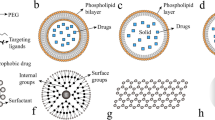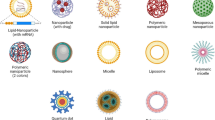Abstract
Our aim was to investigate the cellular uptake, in vitro cytotoxicity and bioavailability of ginsenoside-modified nanostructured lipid carrier loaded with curcumin (G-NLC). The formulation was prepared by melt emulsification technique, in which water was added to the melted lipids and homogenized to give a uniform suspension of NLC (without ginsenoside) and G-NLC. Cellular uptake of curcumin in two colon cancer cell lines (HCT116 and HT29) was increased when administered using both NLC and G-NLC compared to control (curcumin dissolved into DMSO) as measured by fluorescence microscopy. Ginsenoside modification resulted in 2.0-fold and 1.4-fold increases in fluorescence intensity in HCT116 and HT29 cell lines, respectively, compared to plain NLC. In vitro cytotoxicity (assessed by MTT assay) had a dose-dependent relationship with curcumin concentration for both NLC and G-NLC. Although G-NLC was taken up more readily in HCT116 cells, ginsenoside modification did not produce a significant increase in cytotoxic effect; a significant increase was observed in HT29 cells. Oral administration of G-NLC in ten colon cancer patients produced an appreciable plasma level of unbound curcumin (2.9 ng/mL). In conclusion, introduction of ginsenoside into NLC enhanced the cellular uptake and cytotoxicity of curcumin as well as its oral bioavailability, and this strategy can be used to improve clinical outcomes in the treatment of colon cancer with similar genotype to HT29.






Similar content being viewed by others
References
Parsamanesh N, Moossavi M, Bahrami A, Butler AE, Sahebkar A. Therapeutic potential of curcumin in diabetic complications. Pharmacol Res. 2018;136:181–93.
Hatcher H, Planalp R, Cho J, Torti FM, Torti SV. Curcumin: from ancient medicine to current clinical trials. Cell Mol Life Sci. 2008;65:1631–52.
Wilken R, Veena MS, Wang MB, Srivatsan ES. Curcumin: a review of anti-cancer properties and therapeutic activity in head and neck squamous cell carcinoma. Mol Cancer. 2011;10:1–19.
Prasad S, Tyagi AK, Aggarwal BB. Recent developments in delivery, bioavailability, absorption and metabolism of curcumin: the golden pigment from golden spice. Cancer Res Treat. 2014;46:2–18.
Mahmood K, Zia KM, Zuber M, Salman M, Anjum MN. Recent developments in curcumin and curcumin based polymeric materials for biomedical applications: a review. Int J Biol Macromol. 2015;81:877–90.
Strimpakos AS, Sharma RA. Curcumin: preventive and therapeutic properties in laboratory studies and clinical trials. Antioxid Redox Signal. 2008;10:511–46.
Epstein J, Sanderson IR, MacDonald TT. Curcumin as a therapeutic agent: the evidence from in vitro, animal and human studies. Br J Nutr. 2010;103:1545–57.
Schiborr C, Kocher A, Behnam D, Jandasek J, Toelstede S, Frank J. The oral bioavailability of curcumin from micronized powder and liquid micelles is significantly increased in healthy humans and differs between sexes. Mol Nutr Food Res. 2014;58:516–27.
Chaurasia S, Patel RR, Chaubey P, Kumar N, Khan G, Mishra B. Lipopolysaccharide based oral nanocarriers for the improvement of bioavailability and anticancer efficacy of curcumin. Carbohydr Polym. 2015;130:9–17.
Sharma RA, Steward WP, Gescher AJ. Pharmacokinetics and pharmacodynamics of curcumin. Adv Exp Med Biol. 2007;595:453–70.
Vareed SK, Kakarala M, Ruffin MT, Crowell JA, Normolle DP, Djuric Z, et al. Pharmacokinetics of curcumin conjugate metabolites in healthy human subjects. Cancer Epidemiol Biomark Prev. 2008;17:1411–7.
Shoba G, Joy D, Joseph T, Majeed M, Rajendran R, Srinivas PS. Influence of piperine on the pharmacokinetics of curcumin in animals and human volunteers. Planta Med. 1998;64:353–6.
Christensen LP. Ginsenosides: chemistry, biosynthesis, analysis, and potential health effects. Adv Food Nutr Res. 2008;55:1–99.
Leung KW, Wong AS. Pharmacology of ginsenosides: a literature review. Chin Med. 2010;5:20.
Baskaran R, Madheswaran T, Sundaramoorthy P, Kim HM, Yoo BK. Entrapment of curcumin into monoolein-based liquid crystalline nanoparticle dispersion for enhancement of stability and anticancer activity. Int J Nanomedicine. 2014;9:3119–30.
Madheswaran T, Baskaran R, Sundaramoorthy P, Yoo BK. Enhanced skin permeation of 5α-reductase inhibitors entrapped into surface-modified liquid crystalline nanoparticles. Arch Pharm Res. 2015;38:534–42.
Vijayakumar A, Baskaran R, Maeng HJ, Yoo BK. Ginsenoside improves physicochemical properties and bioavailability of curcumin-loaded nanostructured lipid carrier. Arch Pharm Res. 2017;40:864–74.
Sundaramoorthy P, Baskaran R, Mishra SK, Jeong KY, Oh SH, Yoo BK, et al. Novel self-micellizing anticancer lipid nanoparticles induce cell death of colorectal cancer cells. Colloids Surf B: Biointerfaces. 2015;135:793–801.
Safe S, Kasiappan R. Natural products as mechanism-based anticancer agents: sp transcription factors as targets. Phytother Res. 2016;30:1723–32.
Singh S, Khar A. Biological effects of curcumin and its role in cancer chemoprevention and therapy. Anti Cancer Agents Med Chem. 2006;6:259–70.
Gianfredi V, Nucci D, Vannini S, Villarini M, Moretti M. In vitro biological effects of sulforaphane (SFN), epigallocatechin-3-gallate (EGCG), and curcumin on breast cancer cells: a systematic review of the literature. Nutr Cancer. 2017;69:969–78.
Sa G, Das T. Anticancer effects of curcumin: cycle of life and death. Cell Div. 2008;3(1):14.
Ravindran J, Prasad S, Aggarwal BB. Curcumin and cancer cells: how many ways can curry kill tumor cells selectively? AAPS J. 2009;11:495–510.
Patil S, Choudhary B, Rathore A, Roy K, Mahadik K. Enhanced oral bioavailability and anticancer activity of novel curcumin loaded mixed micelles in human lung cancer cells. Phytomedicine. 2015;22:1103–11.
Ji H, Tang J, Li M, Ren J, Zheng N, Wu L. Curcumin-loaded solid lipid nanoparticles with Brij78 and TPGS improved in vivo oral bioavailability and in situ intestinal absorption of curcumin. Drug Deliv. 2016;23:459–70.
Antony B, Merina B, Iyer VS, Judy N, Lennertz K, Joyal S. A pilot cross-over study to evaluate human oral bioavailability of BCM-95CG (Biocurcumax), a novel bioenhanced preparation of curcumin. Indian J Pharm Sci. 2008;70:445–9.
Jäger R, Lowery RP, Calvanese AV, Joy JM, Purpura M, Wilson JM. Comparative absorption of curcumin formulations. Nutr J. 2014;13:1–8.
Sundaramoorthy P, Ramasamy T, Mishra SK, Jeong KY, Yong CS, Kim JO, et al. Engineering of caveolae-specific self-micellizing anticancer lipid nanoparticles to enhance the chemotherapeutic efficacy of oxaliplatin in colorectal cancer cells. Acta Biomater. 2016;42:220–31.
Cuomo J, Appendino G, Dern AS, Schneider E, McKinnon TP, Brown MJ, et al. Comparative absorption of a standardized curcuminoid mixture and its lecithin formulation. J Nat Prod. 2011;74:664–9.
Acknowledgements
We thank Dr. Sung Won Park for his assistance with clinical study.
Funding
This study was supported by the Research Center Hospital Project of Gachon University Gil Medical Center (FRD2014-06-02).
Author information
Authors and Affiliations
Corresponding authors
Ethics declarations
The study protocol was approved by the Institutional Review Board of Gachon University Gil Medical Center (GAIRB2015-87), and written informed consent was obtained from patients before their entry into the study.
Conflict of Interest
The authors declare that they have no conflict of interest.
Additional information
Guest Editor: Sanyog Jain
Publisher’s Note
Springer Nature remains neutral with regard to jurisdictional claims in published maps and institutional affiliations.
Rights and permissions
About this article
Cite this article
Vijayakumar, A., Baskaran, R., Baek, JH. et al. In Vitro Cytotoxicity and Bioavailability of Ginsenoside-Modified Nanostructured Lipid Carrier Containing Curcumin. AAPS PharmSciTech 20, 88 (2019). https://doi.org/10.1208/s12249-019-1295-1
Received:
Accepted:
Published:
DOI: https://doi.org/10.1208/s12249-019-1295-1




